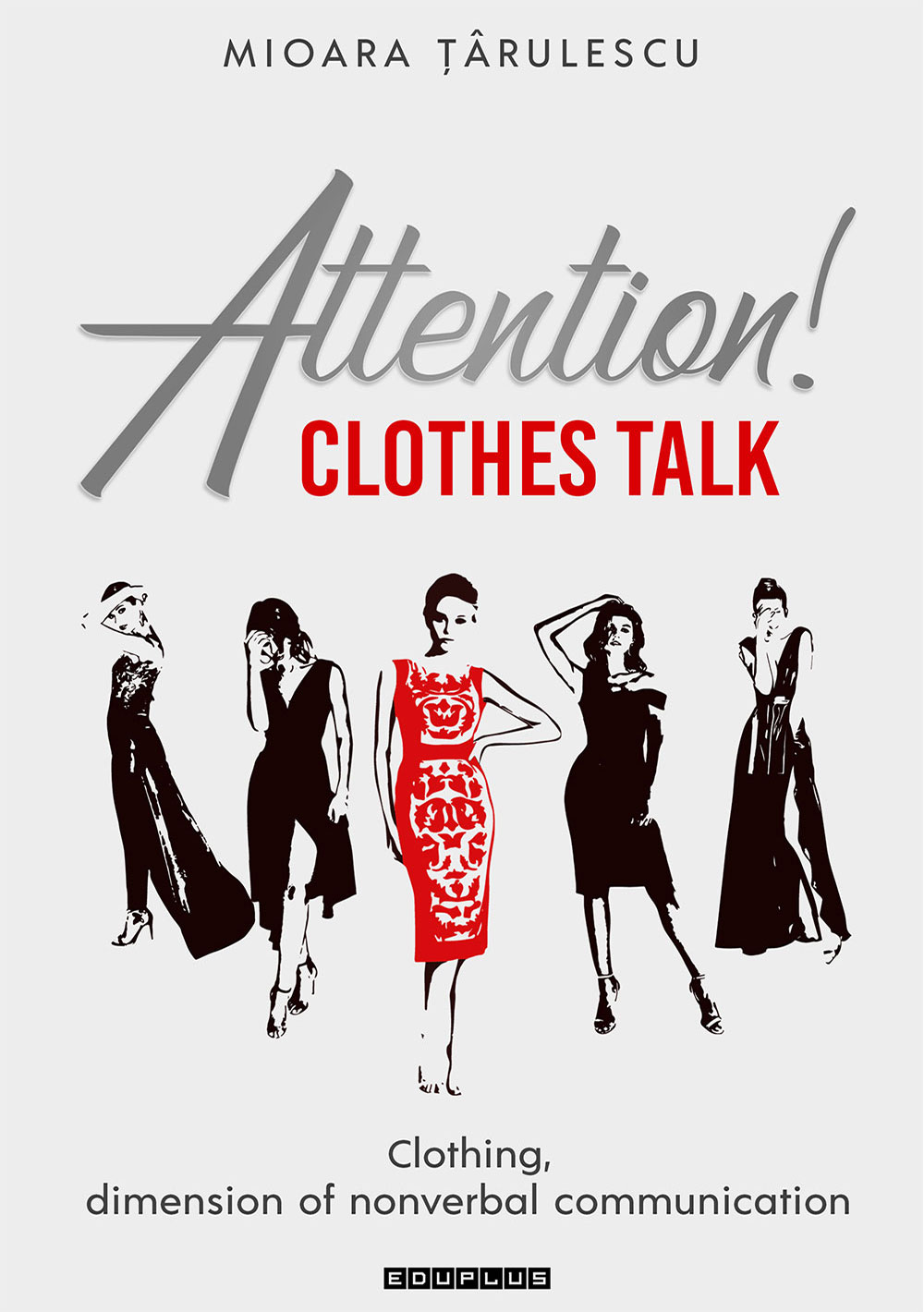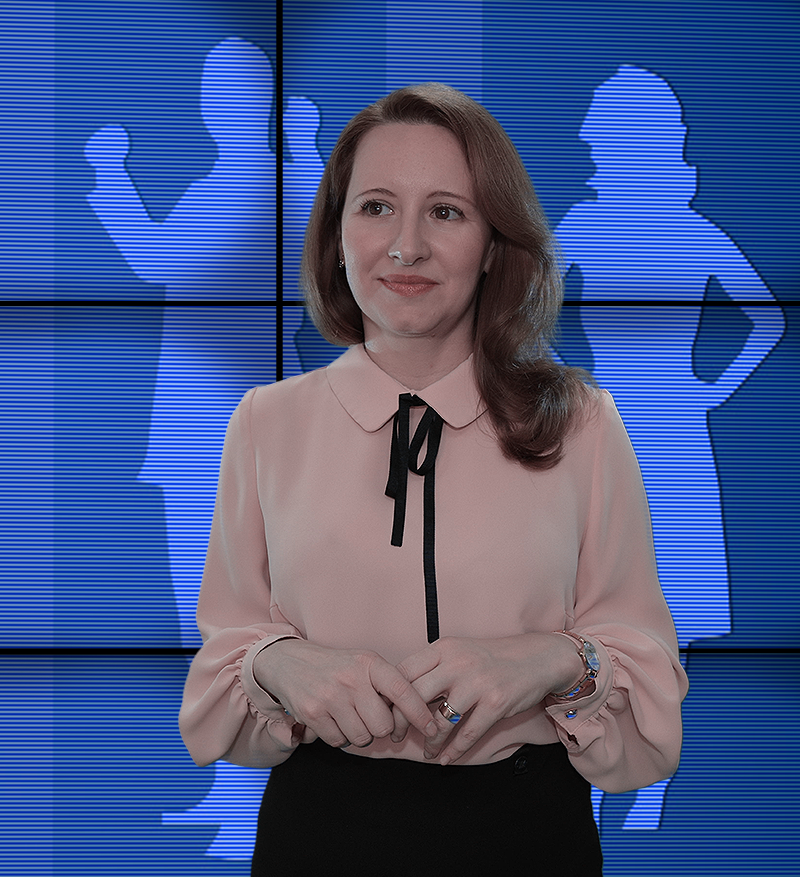Attention! Clothes talk! Clothing, dimension of nonverbal communication
Author: Mioara Țârulescu
Publication year: 2021
Area/field: Psychology
Publishing house: Edu Plus
Number of pages: 332
Version: 
Format: 160x235mm
Edition: Harcover
Graphics: Color - exceptional
ISBN: 978-606-94816-7-7
Description
Clothing is one of the most explicit dimensions of nonverbal communication. It always aroused interest and was the object of naïve psychology analysis, however its degree of subjectivism and lack of substantiation by research did not provide scientific consistency to the analysis. Attention! Clothes talk! Clothing, dimension of nonverbal communication, is a treaty that scientifically substantiates the role of clothing in nonverbal communication, from neuropsychological perspective, by emphasizing the generation, control and explanation mechanisms; from psychological perspective, by creating relations between the emotional sphere – cognitive sphere – conduct – clothing; from sociocultural perspective, by establishing connections between clothing and social roles, expectations and cultural influences.
Although it complies with the rigor of a scientific treaty, the content approach manner, supported by rich graphics, makes it accessible to everyone. The language is easy, the content is focused on practical valences, so that anyone reading this book can use its information immediately. The book does not aim to teach the man how to get dressed, but how to use clothes to win and maintain personal, emotional and cognitive balance, to understand the mood, emotions, intentions of other persons and to build beautiful and efficient relationships with the others. To feel better with oneself and others!
The tailor makes the man! But man chooses the clothes!
Content
Chapter I- The colours and how they influence the emotional area: Neuropsychological analysis. Basic colours. Pure colours and how they imprint the emotional sphere. Non colours. Combining colours.
Chapter II- Communication and body meaning: Psycho-anatomic meanings. The shoulders - the headquarters of responsibility. The arms- the dualism of nonverbal expression. Neck, bust, chest - extremism of manifestations. Waist, hips and buttocks - the transmission of emotional ambivalence. Legs - the stars of nonverbal communication through clothing.
Chapter III- Self-knowledge through clothing: Self-image. Self-identity and clothing style.
Chapter IV- Social role of clothing: Psycho-social adaptation by clothing. Clothing and first impression. Clothes and interpersonal attraction.
Chapter V- Practicing the interpretation of clothes language.
Book fragments
”Yes, clothes talk! Often, they say more than we want to show! They are voluntary or involuntary expressions of our emotions, intentions, interests, but also useful tools when they are at the fingertips of those who understand their importance, the major role in conscious communication of what the unconscious wants to withhold.”
”I don’t teach you what to wear and what not to wear, but I tell you what you are passing through clothing and how you can use it. If you just want to look great, in these pages you will not find solutions. If you want to feel great, then this book is exactly what you need! And I guarantee that if you feel wonderful, you will look great!”
”We choose clothes, and our choice reflects our mood, desires and intentions, but also our personality traits. The color is an external factor turned into a subjective state that influences or nourishes our emotional sphere, with visible effects on our intentions, our conduct, our actions and relationships. When we open the closet and choose a dressing item, the first unconscious selection criterion is the color, because it has to be in line with what we feel or express what we want to feel.”
”Starting from these psychosocial attributes of clothing, we established a causal relationship between self-identity and clothing style, defining psychologically six styles, namely classic, romantic, natural, dramatic, creative, elegant. Each clothing style reflects the way in which the states of the self-image are crystallized, how the self-identity is formed, and so the classical style is characteristic of the person with a well-crystallized self-image, where the Cognitive Ego dominates, but also the Spiritual Ego and the Emotional Ego; the romantic style is characteristic of a woman who likes to show affection, to use her emotions; the natural style is the style of the self-centered person who does not take as reference the opinions of those around him/her, who does not govern his/her life according to the expectations of others but is not in opposition to them; the dramatic style characterizes the person trying to get out of the box, but not in a creative, innovative way, but by exaggerating the "normal"; the creative style involves a struggle with the patterns, but by breaking them, it differs from the dramatic style by canceling the normal, not by exaggerating it, but by novelty; the elegant style is also a style of exaggeration, but not in the sense of getting out of box but by placing oneself to the limit.”
”Social attractiveness is sought at any age, but the indicators are different, and how the person can adapt, operationalize these indicators, depends on self-efficiency, self-confidence, personal, relational, professional and social success. Someone who forsakes being attractive, when (s)he forgets to stand out, to show her/his value, gives up his/her essence, what defines him/her, his/her human and social side. So for us and for others, we have a duty to be attractive, socially, to be accepted or at least not to be rejected.”
”I dare you! Look at the contents of this book critically! Don’t trust blindly everything in it! Say: “I don’t believe. I need to see by myself!” And put into practice, check as much of the information you find between the covers of this book. I guarantee the scientific content of the information, but your critical spirit would guarantee their learning, understanding and application, and the gain would be on both sides: mine because my work is worthwhile, yours, because you manage to stand out, the way you really deserve.”
Mioara Țârulescu
I am psychopedagogue, professor, author, specialist in the psychology of communication, a title obtained through university and post-university specialty studies, supported by the tens of thousands of pages learned, hundreds of exams passed, hundreds of courses in communication over the past 10 years.
”When was the last time you were worried about your clothes? How did you express these worries? Was it something more of an assessment of your wardrobe or maybe a shopping spree? If the answer is no, you now have the opportunity to put on a smart, subtle, theoretical, yet practical analysis of the clothes science. The author worn, in turn, the philosopher’s toga, garnished with the delicate tissue of neuro-psychology or the theories of communication and enabled the clothes’ power to communicate our inner self in such a way that it makes sense only when meeting someone else.”
Dr. Liliana Bujor - Psychologist, Psychotherapist
”This book is a practical guide to behavior analysis, but also to research results in neuro-psychology. The great accomplishment of the author resides in identifying significances that can be easily interpreted by specialists in this field, but also by the reader interested in self-knowledge.”
Dr. Nicoleta Rogoz - Psychologist, Psychotherapist, University professor

